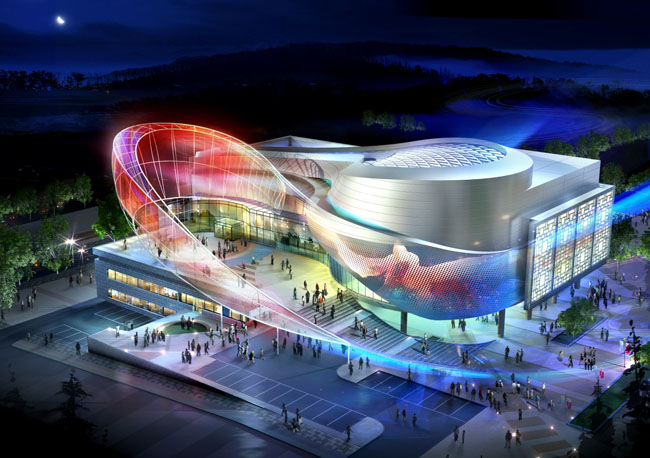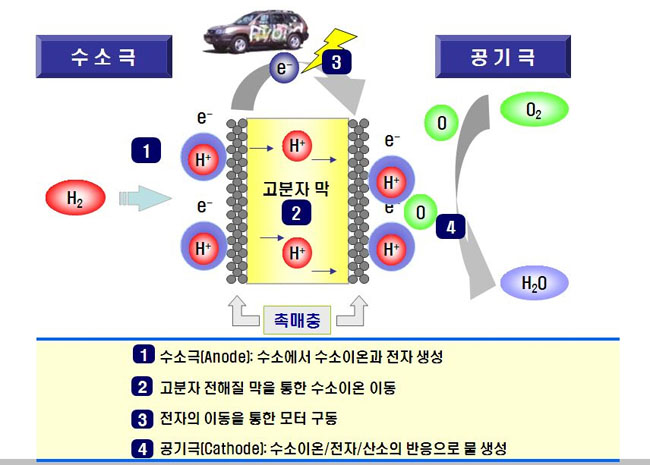World’s First Hydrogen-Powered Building Makes Its Debut at Yeosu Expo
- Date
- 2011.10.28 13:30
- Views
- 877
- Registrar
- 관리자
The Organizing Committee for Expo 2012 Yeosu Korea announced on September 17 that the Korea Pavilion at Yeosu Expo is to run completely on hydrogen power, the first building of its kind in the world.
According to the Organizing Committee, the original plan was to install LNG fuel cells, but it was changed to use hydrogen to power the pavilion thanks to active cooperation with the Hyundai Motor Company which owns the original technology of hydrogen fuel cells.
▽ Digital Rendition of the Korea Pavilion
Hydrogen combustion produces no carbon dioxide unlike natural gas combustion. Hyundai Motor has been keenly developing hydrogen fuel cells for vehicles, but will apply its hydrogen power technology to the Korea Pavilion for the first time. It is expected to take about five months to manufacture hydrogen fuel cells for the Korea Pavilion, and construction of the pavilion is scheduled to be completed by February 2012.
Two hydrogen fuel cells with the capacity to generate 50 kilowatts of electricity will be installed in the Korean Pavilion. If it is supposed that the Korea Pavilion is operated 24/7 for one entire year, the use of hydrogen fuel cells would reduce carbon-dioxide emissions by about 400 tons annually, compared to that of LNG fuel cells. This volume is equivalent to the emissions of a Hyundai Sonata making 2,400 round trips from Seoul to Busan.
“Thanks to the installation of hydrogen fuel cells, the Korea Pavilion will be a symbol of Yeosu Expo’s strong will to realize an environment-friendly global event,” said Cho Sung-je, Deputy Director General of the Organizing Committee’s Facilities Department II. “We expect this achievement to enhance public awareness of climate change and the importance of curbing greenhouse gas emissions.”
수소극 Anode
공기극 Cathode
고분자 막 Polymer membrane
촉매층 Catalyst bed
1. Anode: Hydrogen ions and electrons are generated from hydrogen
2. Hydrogen ions move through the polymer electrolyte membrane
3. The movement of electrons move the motor
4. Cathode: Water is created through the reaction of hydrogen ions, electrons, and oxygen
▽ Principle of hydrogen fuel cells
the source of news : EXPO 2012 YEOSU KOREA - http://eng.expo2012.kr/
According to the Organizing Committee, the original plan was to install LNG fuel cells, but it was changed to use hydrogen to power the pavilion thanks to active cooperation with the Hyundai Motor Company which owns the original technology of hydrogen fuel cells.
▽ Digital Rendition of the Korea Pavilion
Hydrogen combustion produces no carbon dioxide unlike natural gas combustion. Hyundai Motor has been keenly developing hydrogen fuel cells for vehicles, but will apply its hydrogen power technology to the Korea Pavilion for the first time. It is expected to take about five months to manufacture hydrogen fuel cells for the Korea Pavilion, and construction of the pavilion is scheduled to be completed by February 2012.
Two hydrogen fuel cells with the capacity to generate 50 kilowatts of electricity will be installed in the Korean Pavilion. If it is supposed that the Korea Pavilion is operated 24/7 for one entire year, the use of hydrogen fuel cells would reduce carbon-dioxide emissions by about 400 tons annually, compared to that of LNG fuel cells. This volume is equivalent to the emissions of a Hyundai Sonata making 2,400 round trips from Seoul to Busan.
“Thanks to the installation of hydrogen fuel cells, the Korea Pavilion will be a symbol of Yeosu Expo’s strong will to realize an environment-friendly global event,” said Cho Sung-je, Deputy Director General of the Organizing Committee’s Facilities Department II. “We expect this achievement to enhance public awareness of climate change and the importance of curbing greenhouse gas emissions.”
수소극 Anode
공기극 Cathode
고분자 막 Polymer membrane
촉매층 Catalyst bed
1. Anode: Hydrogen ions and electrons are generated from hydrogen
2. Hydrogen ions move through the polymer electrolyte membrane
3. The movement of electrons move the motor
4. Cathode: Water is created through the reaction of hydrogen ions, electrons, and oxygen
▽ Principle of hydrogen fuel cells
the source of news : EXPO 2012 YEOSU KOREA - http://eng.expo2012.kr/



